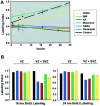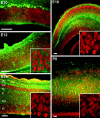Differential modulation of proliferation in the neocortical ventricular and subventricular zones
- PMID: 10908617
- PMCID: PMC3823557
- DOI: 10.1523/JNEUROSCI.20-15-05764.2000
Differential modulation of proliferation in the neocortical ventricular and subventricular zones
Abstract
Recent studies have implicated the classical neurotransmitters GABA and glutamate in the regulation of neural progenitor proliferation. We now show that GABA and glutamate have opposite effects on the two neural progenitor populations in the ventricular zones (VZs) and subventricular zones (SVZs) of the embryonic cerebrum. Application of either molecule to organotypic slice cultures dramatically increases proliferation in the VZ by shortening the cell cycle, whereas proliferation in the SVZ is decreased. These disparate effects, measured both by bromodeoxyuridine uptake and the expansion of retrovirally labeled progenitor clones, are mimicked by the application of specific GABA and glutamate agonists and are blocked by antagonists. Thus, the relative contributions of the VZ and SVZ to neocortical growth may be regulated by differential responsiveness to GABA and glutamate.
Figures








References
-
- Altman J. Autoradiographic and histological studies of postnatal neurogenesis. IV Cell proliferation and migration in the anterior forebrain, with special reference to persisting neurogenesis in the olfactory bulb. J Comp Neurol. 1969;137:433–458. - PubMed
-
- Antonopoulos J, Pappas IS, Parnavelas JG. Activation of the GABAA receptor inhibits the proliferative effects of bFGF in cortical progenitor cells. Eur J Neurosci. 1997;9:291–298. - PubMed
Publication types
MeSH terms
Substances
Grants and funding
LinkOut - more resources
Full Text Sources
Other Literature Sources
Medical
